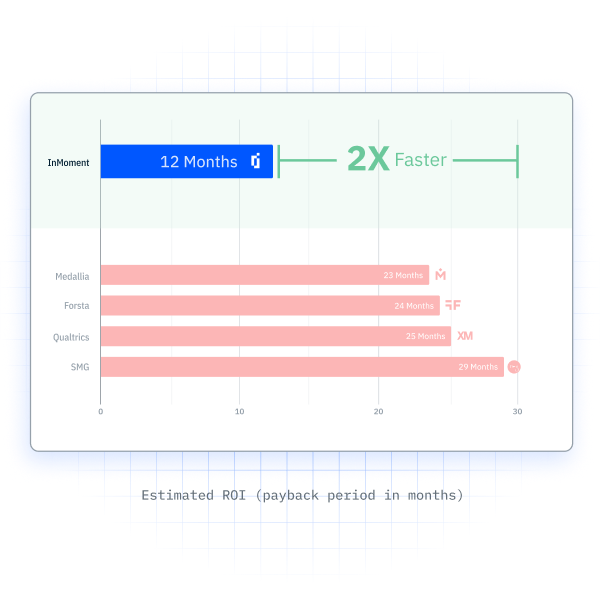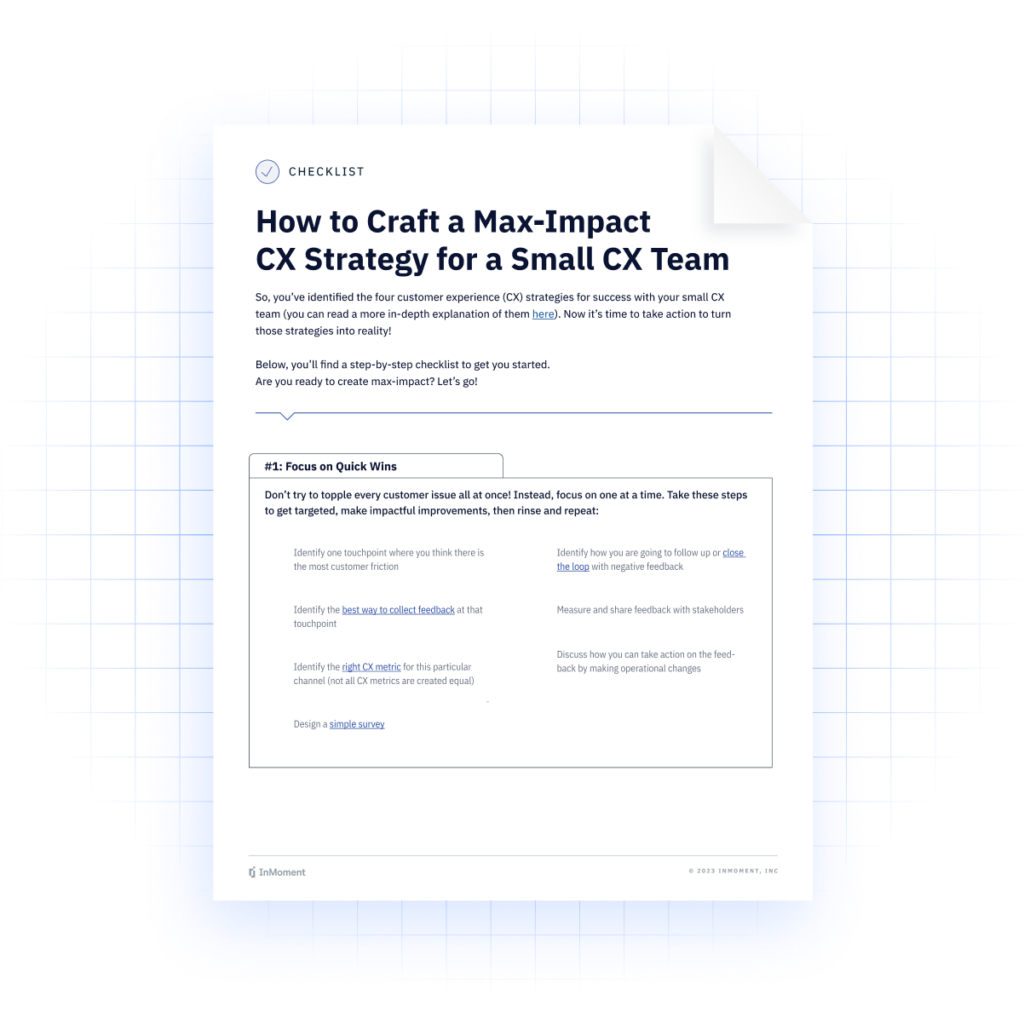Where Should Customer Experience (CX) Teams Live Within An Organization?
CX teams are responsible for spearheading an organization's customer experience efforts. These teams need to be equally skilled and flexible in order to succeed in today’s customer experience market. Where these teams live in your organization is dependent on the goals and structure of your business.
Did you know that only 20% of CX teams report directly to the CEO? The other 80% of CX teams report to 15 different leadership functions, with CTO and Chief Customer Officer being the second and third most common leadership functions.
These statistics show that there is no standard for where a CX team should live within your organization. To accurately place a CX team, you need to have a firm understanding of what CX teams do, what the customer experience goals of your organization are, and where those two overlap.
What Is A CX Team?
A CX team is a group of customer experience professionals who work to improve customer experience by sharing customer insights throughout the organization. They analyze customer feedback, customer journeys, and more to get the most up-to-date information about the current customer experience and where it can be improved.
Who Is On A CX Team?
The number of employees on a CX team and their respective titles will vary depending on the company. For example, a company that just established a CX team will have fewer employees than a company with an enterprise-wide CX team.
Regardless, the core team members of a CX team are:
- CX Managers: Oversee strategy and execution.
- Data Analysts: Dive deep into customer data to uncover actionable insights.
- Journey Designers: Map out customer interactions to identify gaps and opportunities.
- VoC Specialists: Ensure customer feedback is heard and acted upon.
What Skills Are Needed on A CX Team?
Members of a CX team need to be versatile employees who can examine different types of data. These employees must be able to research, analyze, and prevent all customer-related findings to organizational stakeholders. A recent study of CX teams said the three most common skills of employees on a CX team are:
- Qualitative research
- Quantitative research
- Project management
What Skills Will Be Needed On A CX Team In the Future?
To keep up with ever-evolving customer expectations, CX teams will need employees who can grow and ensure that an organization can still be successful. The three skills that CX team employees need to have in the future are:
- Data science or analytics
- Business case development
- Inclusive design/accessibility testing
These skills reflect changes in the customer experience market and what is going to needed of organizations to stay successful.
How to Build a CX Team
Building an effective CX team requires careful planning and alignment with your organization’s goals and customer needs. Follow these steps to ensure you assemble a team that will drive meaningful results:
- Secure leadership buy-in
- Define the team’s purpose and goals
- Identify the right roles and skills
- Select the right tools and technology
- Establish clear processes
- Foster cross-department collaboration
- Continuously train and develop the team
- Measure and Optimize
1. Secure Leadership Buy-In
For a CX team to succeed, you need the full support of senior leadership. The executives must understand the importance of a CX team and be willing to provide the necessary resources. In this step, you will also decide which executive leader the CX team will report to.
2. Define the Team’s Purpose and Goals
Before you can hire and assign roles to employees, you need to clearly define your CX team’s mission. Determine what customer challenges the team will address, how success will be measured, and how the team aligns with broader business goals. Examples of CX team goals include:
- Increasing customer retention by improving satisfaction
- Increase customer acquisition by improving the customer journey
- Driving higher Net Promoter Scores (NPS) through targeted strategies
Clearly defined goals will guide the hiring process and set the foundation for CX success.
3. Identify the Right Roles and Skills
With the purpose of your CX team defined, you can now begin the hiring process. Your CX team should include diverse roles that collectively address all aspects of the customer experience. Common roles on a CX team include:
- CX Manager
- Data Analyst
- Customer Journey Designer
- VoC Specialist
In addition to technical skills, look for individuals who can perform qualitative and quantitative research, possess great communication skills, and are experienced in project management.
4. Select the Right Tools and Technology
In order to give your CX team the best chance to succeed, you need to have the right tools at your disposal. These tools might include Voice of the Customer platform, journey mapping software, conversational intelligence, or data analytics tools.
InMoment’s customer experience platform is an all-in-one solution that lets you collect and connect customer experience data in every format across every customer interaction. InMoment’s integrated CX approach helps organizations realize ROI in just 12 months, which is more than twice as fast as the industry average.

5. Establish Clear Processes
It is important to develop workflows to guide a CX team’s activities. For example, you will need to define how customer feedback will be collected, analyzed, and shared. You will also need to create a process for collaborating with other departments to address CX challenges across the organization.
6. Foster Cross-Department Collaboration
CX teams don’t operate in isolation. They must collaborate with other departments, including marketing, sales, product development, and customer service. Encourage open communication and shared accountability by hosting regular meetings to align on customer-centric strategies, using collaborative tools to ensure visibility, and more.
7. Continuously Train and Develop the Team
The customer experience market is constantly changing. It is important to invest in skill development. This can be done by attending customer experience events, training on new tools and technologies, and getting certifications in CX methodologies.
8. Measure and Optimize Performance
Being able to measure the performance of a CX team against customer experience KPIs is crucial for the longevity of a CX team. Regularly review these metrics and gather team feedback to refine processes and improve outcomes.
CX Team Challenges
Although they are important to the success of an organization, even the best CX teams do not come without challenges. These challenges can affect CX teams across all organizations, here are the main ones to be aware of:
Lack of Executive Support
Over 40% of CX teams in an organization that prioritizes CX say they do not have consistent executive support. This suggests that despite the organization’s overall commitment to enhancing customer experience, there remains a significant gap in the backing and resources that these teams receive from higher management, which can ultimately hinder their effectiveness and the overall success of CX initiatives.
Inconsistent Business Case Development
A recent study found that only 22% of CX decision-makers make a business case for customer experience for every project or initiative and that only a third of them make a business case for major initiatives.
In order CX teams to become an integral part of the organization, it is important to make business cases for all initiatives on how they will impact the customer experience at your organization.
Misaligned Priorities
When prioritizing customer experience initiatives, most CX teams primarily concentrate on customer impact. However, almost half of CX teams often overlook three important criteria: return on investment, feasibility, and risk. To gain and maintain the support of key stakeholders within the organization, CX teams need to give more attention to these three factors.
Considering ROI is vital for justifying CX efforts to key stakeholders concerned about any initiative’s financial implications. Assessing feasibility includes evaluating the existing operational capabilities and potential barriers that could hinder the execution of the initiatives. Lastly, risk assessment is an essential component that cannot be neglected. Every initiative carries inherent risks that could impact customer satisfaction, brand reputation, or financial performance.
Lastly, risk assessment is an essential component that cannot be neglected. Every initiative carries inherent risks that could impact customer satisfaction, brand reputation, or financial performance.
By considering ROI, feasibility, and risk alongside customer impact, CX teams can enhance their strategic planning. This comprehensive approach not only helps secure the support of key stakeholders but also ensures that CX initiatives are sustainable and aligned with the broader business objectives.
Where Should CX Teams Report?
Regardless of where your CX team lives, the team must remain unbiased and have the purview to work cross-functionally to drive collaboration and break down silos. Without that organizational freedom and neutrality, the team’s efforts are already handcuffed, and the chances of CX success are greatly diminished.
While many companies have added a seat at the table for a Chief Customer Officer (CCO) or Chief Experience Officer (CXO) in recent years, we still see most CX functions report to either marketing (the CMO) or operations (the COO). There are pros and cons to each of these reporting relationships:
The Pros and Cons of Your CX Team Reporting to Marketing & the CMO:
Pros:
- Tied More Closely to the brand promise of the organization (since CX is the fulfillment of that promise)
- Tied more closely to the communication function. Too many CX functions don’t think about the role communication plays in the overall experience, but this is where the customer expectations get set
- Part of a more holistic view of the company and the customer journey
- Marketing (or strategy) is more likely to consider the experience of the future as opposed to only today’s experience
Cons:
- May be too far removed from the actual frontline customer interactions, so it can be more difficult to implement change
- Often too closely tied to marketing’s priorities and budget
- Can marketing enforce an effective closed-loop process if that work happens elsewhere in the organization?
- Marketing is often more focused on customer acquisition and top-of-funnel activities
The Pros and Cons of Your CX Team Reporting to Operations & the COO:
Pros:
- More closely tied to frontline customer interactions
- Typically has good success with enforcing a strong closed-loop process (if staffed and funded properly)
- Operations typically focused and measured on customer retention
Cons:
- Unless digital and call centers report to the COO, the program can get too focused on in-person or physical interactions
- Can be too focused on break/fix of today’s experience and not focused on overall CX strategy, process redesign, or experience design. Programs can get very tactical
- Susceptible to budget cuts and quarterly targets, whereas CX tends to be a medium-to-long term proposition
The Pros and Cons of Your CX Team Reporting to Executives Such as the CEO:
Pros:
- Easier alignment to executive goals and buy-in
- Budget is set aside specifically for one purpose and can have less constraints
- Easier to build relationships around CX with each department to break down silos
Cons:
- Difficult to get all departments aligned to taking action as they can be seen as an outsider
- More difficult to be in synch with the day-to-day business rhythm
- Focus often on medium- or long-term initiatives while peers focus on quarterly results
CX Team Best Practices
While the focuses and goals of CX teams can change from organization to organization, certain things will set you up for success regardless of your objectives. Here are some best practices to ensure your CX team can succeed in any environment:
Democratize Data
Democratizing data is an important step for protecting your teams’ time and resources, and it can be performed at any stage of CX maturity!
Invest the time needed with key stakeholders to explain the importance of customer experience, co-create dashboards, and reduce any ambiguity about CX programs. By spreading the responsibility between team members throughout your business, you will save time both now and down the line with fewer emails, more empowered colleagues, and more visibility of your hard work.
Leverage Available Resources
Technology alone won’t help with demonstrating a return on investment. The most effective programs have a strategic partner to help map the initial CX framework, discover those actionable insights and point out the cost savings along the way.
You need a motivated team behind yours to design the roadmap of experience management success. Best practices show that the financial impact of the CX capability is outlined in the onboarding process, tested and controlled along the way, and measured and reported quarterly.
Create CX Champions
Take time upfront to educate teammates on the importance of customer experience and ask for volunteers to champion such initiatives across various departments. The more stakeholders invested in a CX program, the more time practitioners will have to delegate responsibilities across a business.
See which people in your business are organically gravitating toward your CX program and formalize their role as a CX champion. Empower these individuals to access the CX data anytime, anyplace to drive action.
Level-Up Your Dashboards
When you have a customer experience dashboard that is intuitive and easy to understand, stakeholders can easily circulate them within the organization. An effective dashboard is designed to guide the user, not overload the user with data.
We recommend you follow this design structure where possible:
- Main KPI: Where are we? How has our performance changed over time?
- Main KPI & Main Segment: Who/what should we focus on?
- Sub KPIs: What is contributing to our core metric?
- High-Level Text Analytics: What overall are our customers telling us?
- Verbatim: What are our customers actually saying about their experience?
- Deep Analysis: Splitting KPIs up by pre-pop data.
To learn more about best practices and how to succeed as a CX team, download the checklist below:
Customizing CX Team Organization: Considerations for Success
Regarding the reporting relationship of the CX function, one size doesn’t fit all. Every organization, leadership dynamic, employee culture, and business is different. We mentioned above that we have led CX, reporting to the CMO, reporting to the COO, and as an independent function. What we learned is that it can be successful in any of these reporting relationships, though we suggest it has a head start if it reports into the predominant power core of the organization.
Some companies are operations-led, others are sales & marketing-led, while others are product-led. Tying CX to the true cultural and power core of the company, though it brings some of the bias mentioned above, aligns it better with the core of the company.
Regardless of where your CX function reports, there are key organizational elements that must be present and the CX leader also has to have certain key skills, strengths and characteristics for it to be successful.
Improve Your CX Team with InMoment
If your customer experience (CX) team is just starting out or expanding an existing team, InMoment is the top choice for a CX partner. With over 50 years of experience across various industries and a best-in-class solution, InMoment will guide your company in the right direction. To discover how InMoment can benefit your organization, schedule a demo today!
References
Forrester. Predictions 2025: Customer Experience. (https://www.forrester.com/report/predictions-2025-customer-experience/RES181533). Accessed 11/20/2024.
Forrester. Customer Experience Market Insights, 2024. (https://www.forrester.com/report/customer-experience-market-insights-2024/RES181199). Accessed 11/20/2024.
Forrester. The State Of Customer Experience Teams, 2023. (https://www.forrester.com/report/the-state-of-customer-experience-teams-2023/RES180035). Accessed 11/20/2024.







